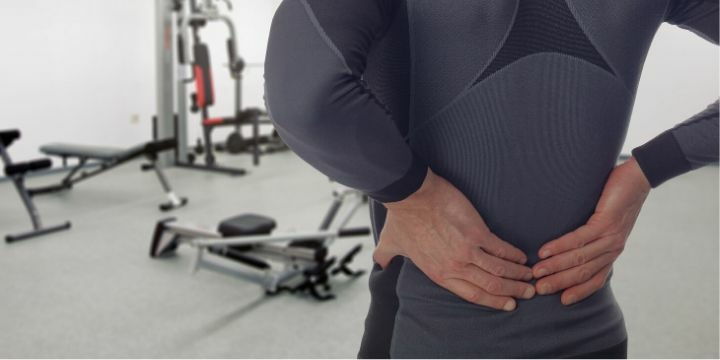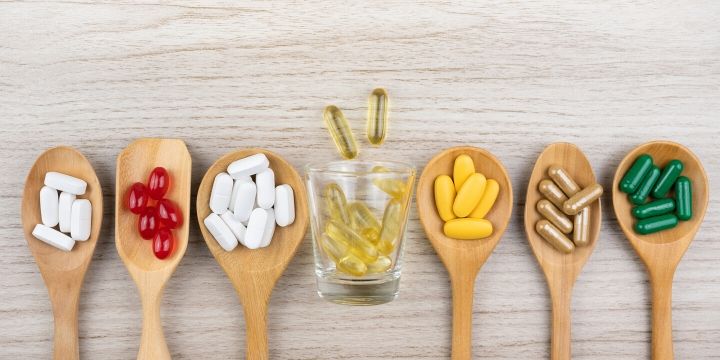Nutrition and supplementation are also gaining an important role in the rehabilitation and integrated treatment of some pathologies such as muscle injuries.
Muscle injuries

Specifically, we can define a muscle injury as a traumatic distraction or an excessive injury to a muscle (1).
This type of damage caused by a traumatic event is classified into:
Indirect muscle injuries
Direct muscle injuries
The first group related to indirect injuries is divided into:
Functional muscle disorders (2, 5).
Functional muscle disorder refers to painful muscle injury with no evidence of damage to the muscle fibers.
Structural muscle injuries (2, 5).
Structural muscle injury consists of any direct acute muscle disorder with gross evidence of muscle fiber damage (4–6).
The first therapeutic approach to muscle injury will be a physiotherapeutic approach using manual techniques and instrumental therapy essential for the damage recovery process (7). However, we can see how from the initial stages of treatment it was found that a nutritional intervention is essential to provide new material necessary for the wound repair process, the control of inflammation and oxidative stress produced by the injury, representing a very useful support. to conventional therapy.
Stages of post-injury recovery
Summarizing in a simple way the history of post-injury recovery we can ideally divide it into 3 phases (8):
Phase 1 - Inflammation [up to 4 days after injury] Immediately after injuries, the first response is inflammation.
Damage has occurred. Injured tissues are deprived of the normal flow of oxygen and nutrient-rich blood.
An onset of cell death occurs. During this phase we have pain, swelling, redness and heat are common.
Phase 2 - Proliferation [4 to 21 days after injury] Once the inflammation is subsided, the damaged tissues are removed and a new vascularization develops.
Additionally, scar tissue is laid to support the injury site.
Phase 3 - Remodeling [21 to 2 years after the injury] The scar tissue that formed several days after the injury is degraded and replaced with stronger connective tissue.
With proper therapeutic and nutritional intervention, this area can be as strong as the original tissue, not injured or even stronger.
Regarding the nutritional approach to recovery, there are many false myths during these phases, we try to investigate further and dispel some of them.
Inflammation and fat intake
Trans fats, omega 6 fatty acids and saturated fats are known to promote inflammation in the body, while monounsaturated fatty acids and omega 3s inhibit inflammation.
This means that it is important to achieve a better balance between omega 6 and omega 3 fatty acids during injury recovery.
By eating less omega 6 and more omega 3, in fact, the amount of inflammation is reduced or better averaged and the production of collagen is better supported. In this case, in addition to the integration of high quality omega fatty acids (from 3 to 9 grams per day), we should also focus on adding or increasing the percentages of foods such as: olive oil, dried fruit, avocado. One of the fundamental concepts that should not be forgotten is that inflammation is a fundamental mechanism during the repair of the lesion and our aim is always to support and mediate it by trying to avoid the effects of excessive production.
In this, the nutritional and integrative strategy plays a fundamental role, especially in the medium-long term avoiding, for example, the side effects of many anti-inflammatory drugs such as NSAIDs.
Nutraceutical approach to inflammation

Herbs and plants can be helpful in managing inflammation, especially during the first phase of recovery.
Turmeric powder: This member of the ginger family has long been used as an anti-inflammatory and for wound healing with its active ingredient which is curcumin.
Adding curry to athletes' diets is not always a good idea, but surely a turmeric supplement could be more effective as the dose is much more concentrated 400-600mg per day of the supplement form can be supportive at this stage.
Garlic: It has been shown to inhibit inflammatory enzymes and increase macrophage function, especially in the form of a 600 to 1,200 mg aged garlic extract supplement.
Pineapple: contains bromelain, another anti-inflammatory plant extract that is excellent for digestion and to relieve excessive inflammation resulting in pain 500-1000 mg in an additional form.
Cocoa, tea and berries: they help manage inflammation through antioxidant activity and influence cell growth and new capillary development during tissue regeneration.
Food supplements containing blueberry or grape, green tea, citrus fruit extracts (hesperidin, naringin, etc.) and bioflavonoid supplements containing quercetin, dihydroquercetin and rutin are linked to more important anti-inflammatory effects.
Probiotics and prebiotics
Probiotics are defined as live microorganisms that confer a benefit to the host's health when administered in adequate quantities (10), currently in sports science, probiotic elements are recommended taking into account their benefits relating to the health of the athlete (11, 12).
It is known that probiotics are able to interact with the immune cells of the gut-associated lymphoid tissue (GALT) improving the efficiency response and the intestinal permeability parameters.
It is possible that indirect probiotics can contribute to the muscle repair process, through the activity of immune cells (number and function of neutrophils and macrophages), reducing the time taken for the repair process.
The use of elementary probiotics, particularly Lactobacillus and Bifidobacterium strains in a daily dose of ≥ 1010 CFU, should help repair the stage of the injury to accelerate the muscle repair process by the action of immune cells (granulocytes and phagocytes ).
Another important role is in the cases of post surgical recovery after the administration of antibiotics. Post-surgical antibiotics are vital for preventing infections, but unfortunately they also kill some of the beneficial gut bacteria involved in our digestive and immune health. Restoring bacteria through the use of probiotics and prebiotics includes benefits and reduces the effects of antibiotics, helping to create a healthy intestinal environment.
How to manage macronutrients in the remodeling phase
During injury repair, the metabolic rate can increase anywhere from 15-50%.
While this seems high, the calorie requirement will actually be lower than that required during sports training.
Eating too few calories during the recovery period can prevent complete and adequate recovery.
Unfortunately, drastically reducing physical activity during periods of injury can lead to a natural reduction in appetite and food intake, so it is important to sensitize the athlete or patient to healthy eating habits and patterns in order to provide total energy sufficient for proper repair.
Immobilization reduces the ability of myofibrillar proteins to respond to amino acid stimuli, a phenomenon called "anabolic resistance" and makes muscle building a more difficult process.
To remedy this, the researchers established higher protein intakes (1.6-2.5 g / kg / day) and emphasize the consumption of leucine-rich foods.
About 1/3 of your body fat should come from each type of fat (i.e. 1/3 saturated fat, 1/3 monounsaturated fat and 1/3 polyunsaturated fat).
Although there is currently no specific research and guidance for carbohydrates during recovery, it is important to include enough carbohydrates to support brain function and provide adequate micronutrient intake.
Micronutrients and remodeling
Vitamins and minerals are nutrients required by the body in small amounts to carry out a variety of metabolic reactions, and as the recovery process of injury relies on many metabolic reactions, they can play a key role.
The main xones involved in the proliferation and remodeling process are:
Vitamin A: improves and supports early inflammation during injury, reverses post-injury immune suppression, and promotes collagen formation. Supplementing with 10,000 IU per day for the first 2-4 weeks after injury is probably a safe approach, higher doses could lead to toxicity so they are not recommended.
Vitamin C: improves the activity of neutrophils and lymphocytes during phase 1 of the acute injury.
It plays an important role in collagen synthesis. It is recommended to supplement 1g-2g / day during the first 2-4 weeks after the injury.
Copper: Helps in the formation of red blood cells and works in concert with vitamin C to form elastin and strengthen connective tissue.
It is recommended to supplement 2-4 mg / day during the first 2-4 weeks after injury.
Zinc: plays a vital role in tissue regeneration and a deficiency has been associated with poor wound healing.
Its recommended to supplement 15-30 mg / day during the first 2-4 weeks after the injury.
Other useful supplements
Arginine: This can stimulate the release of insulin and growth factors that aid in protein synthesis and the deposition of connective tissue.
Its role in stimulating nitric oxide production can increase blood flow to the injured area and activate macrophages for tissue cleaning. Human doses range from 15-30g per day.
Ornithine: This can improve protein metabolism, reduce healing time, increase healing strength, and increase nitrogen retention.
Furthermore, ornithine can be converted to proline, which is essential in the deposition of collagen.
The dosage is in the range of 20-30 g per day (10 g 2-3 times a day).
Glutamine: This is essential for the metabolism of cells that have a rapid turnover, such as lymphocytes and enterocytes.
During times of stress, glutamine must increase.
It has been speculated that glutamine may help accelerate wound healing.
HMB - this leucine metabolite has been shown to inhibit the breakdown of muscle proteins and increase protein balance, leading to potential muscle gains.
HMB can also increase collagen deposition and improve nitrogen balance.
